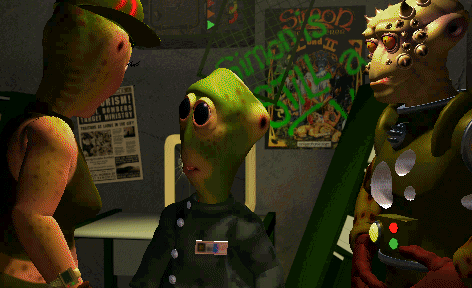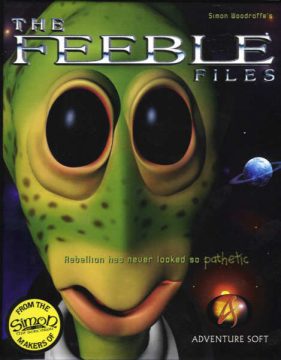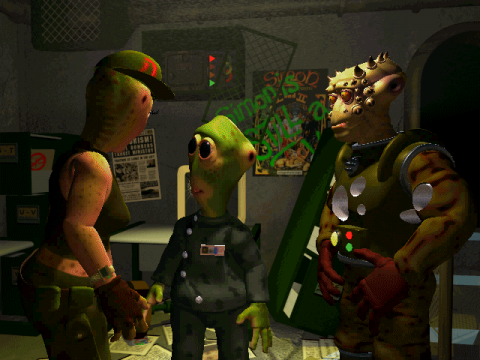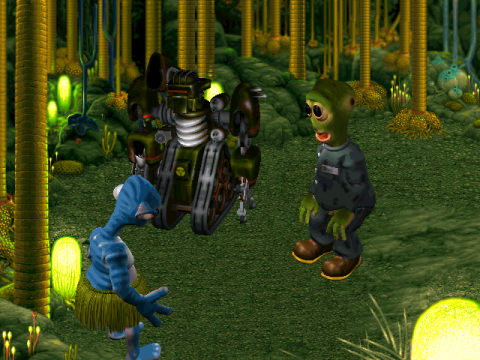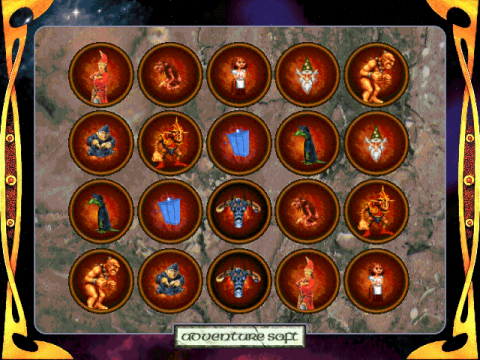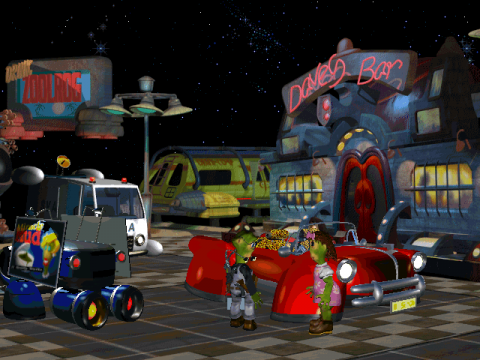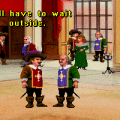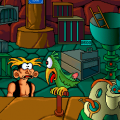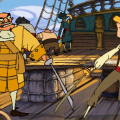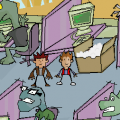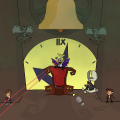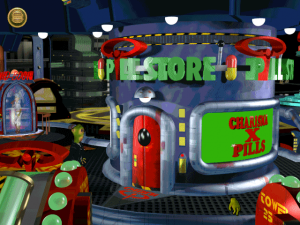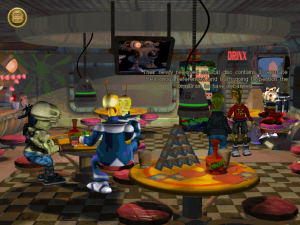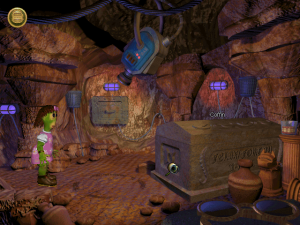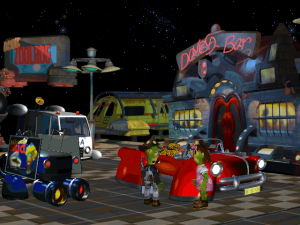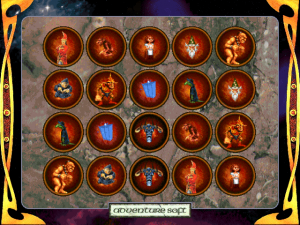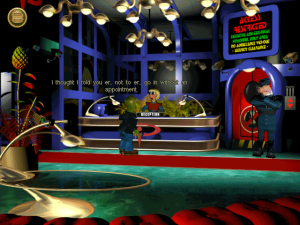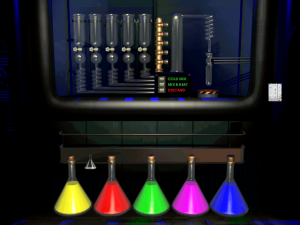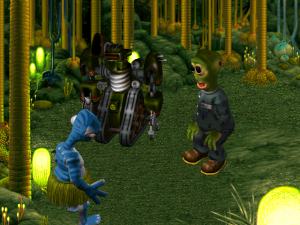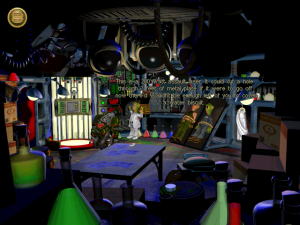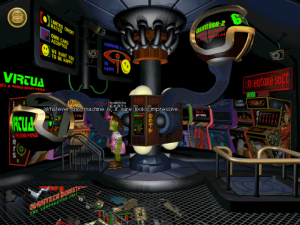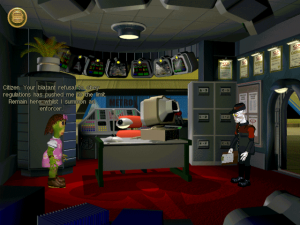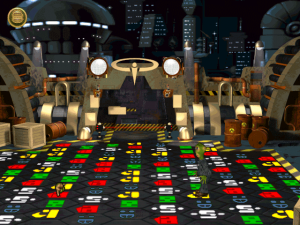The Feeble Files, published in the United Kingdom in 1997, is Adventure Soft’s follow-up to their popular Simon the Sorcerer series. It flopped, apparently, leaving the publisher to rationalize that 2D gaming was dead, and 3D was the way of the future. This, of course, led to Simon the Sorcerer 3D, a total wreck of a game, and the complete opposite of what most fans wanted. While technology definitely played a part in the downfall of the graphic adventure genre, apparently none of the number crunchers looked hard enough at The Feeble Files to see that maybe the quality of the games had something to do with their dwindling popularity. Like Simon, The Feeble Files is pretty funny, but it’s also an overwhelmingly difficult, massively frustrating experience that points to nearly everything that was wrong with adventure game design.
It all starts off cleverly enough. Feeble is an alien who lives in an otherwordly society ruled by a presence known as the OmniBrain. It’s a cheery, totalitarian society, where everyone is either forced into happiness via brainwashing or medication, or otherwise plainly killed. Laws are arbitrarily passed by the ruthless bureaucracy, and government sponsored confession booths offer “prizes” to those who would spill their guts for the greater good. Feeble, of course, is quite happy, him being something of a pushover. His disposition in his profile is listed as “dumpy”, with an expendability rating of 94%, and he is consciously aware that his name means weak and pathetic. He mindlessly works at the Ministry of Uncertainty, in a division which monitors the planet Earth from afar and occasionally makes trips to carve crop circles. But his little life is flung into disarray when he’s blamed for an accident at his job, which is tantamount to treason and causes him to shipped off to a prison colony. Feeble hasn’t quite realized it yet, but he’s been recruited as part of The Freedom Fighters, a rebel group that seeks to liberate society from the grips of the OmniBrain. He’s not exactly the best choice for the situation, but he’ll apparently have to do, as he miraculously escapes from prison, uncovers his past heritage, and attempts to liberate his people from oppression.
There’s quite a bit of George Orwell’s 1984 in there, which makes sense coming from Britain, mixed with a little bit of Aldous Huxley’s Brave New World for good measure. Compared to the Simon the Sorcerer games, which were largely about a snotty teenager belittling fairy tale archetypes, The Feeble Files is a bit more mature, a satirical, tongue-in-cheek story that takes on a very different tone. Feeble’s a likable, sad little chap, regrettably accepting of his terrible fate once he’s arrested, and his journey from weenie to hero is quite endearing. His voice is provided by Robert Llewyllyn, mostly known as the android Kryten from the British sci-fi TV series Red Dwarf, and who provides a sense of politely earnest bewilderment.
The real star of the show, though, is SAM, a violently psychotic robot with the head of a 70s Battlestar Galactica Cylon, who rolls around on tank treads and wields both a rocket launcher and a gigantic buzzsaw. He speaks in a gruff albeit overly polite manner, joyfully requesting when and where his skills of destruction are most appropriate. Think of him as a precursor to the HK-47 droid from Star Wars: Knight of the Old Republic and you’ll have a good idea about the laughs he can bring.
But while the game is funny, parts of it still feel lacking. Simon the Sorcerer (and Monkey Island and Discworld and such) succeeded because the world was populated with weird and silly characters. Feeble has…well, SAM is awesome, but he’s far from a starring character, and the rest of the supporting cast is strangely bland. Similarly, much of the writing feels scaled back, as the low number of hot spots means there’s less stuff for Feeble to comment on, and the dialogue trees are oddly short and to the point. Instead, the background is instead supplied by Oracle, a wrist watch with the stately voice of Peter Tuddenham, the computer from Blake’s 7. There’s a full encyclopedia of Feeble’s society, as well as a running tally of all of apparently criminal misdeeds, numbering near a hundred by the end of the game including “Unnecessary flamboyance when starting a space bike”, “Making advances to a member of the opposite gender without a Hot Love Permit”, and “Attempting to use female charms without being female”. (This wouldn’t be British if there weren’t some level of cross dressing, would it?) It’s a great feature, but it probably would’ve been better had it been integrated better in the game, instead of what amounts to a fancy inventory screen.
The quality of the writing can’t redeem The Feeble Files from its biggest flaw – its extraordinarily difficult, and occasionally quite tedious puzzles. From the very beginning, you’re forced to jump through a number of obnoxious hoops just to visit your boss. You can’t get past the secretary, so you need to charm her by taking some pills. You can’t get the pills because the shipment is held up. You can’t finalize the delivery because you need a permit. You can’t get the permit because the gruffy trucker won’t give it to you. And so forth. The worst of it is when, you finally DO get past the secretary, you’re not allowed in his office because you’re not in your work uniform. It’s not simple enough to just fly back home and change, or jump into the bathroom. No, for some reason, the game concludes that Feeble can only do it Superman-style, inside of a phone booth. Wouldn’t you know, the only two phone booths in the game world are occupied, and, as the game makes you assume, the occupants are talking to each other. One of them, when bothered, will ask Feeble for a drink. You need to get this drink and spike it with some expired medication (whose effects are never given), which causes him to become cross and curse out his girlfriend on the other end, causing them both to hang up. Then, you go to the other phone booth, find it available, change, and then get past the elevator guard to move onto the next chapter.
This is only the first of many, many stupidly designed situations. When trying to escape from prison, you’re presented with a grid of colored tiles. By examining the prison’s credo, you can figure out the correct path – except the minute you step onto it, the colors begin cycling. You need to jump on each tile in the original order before they began changing colors, but you also need to wait for it to cycle to its original color before you can jump. Otherwise, you set off the alarm, and need to restart the whole puzzle. There are roughly thirty tiles in total, and due to the skewed perspective of the screen, it’s easy to accidentally jump onto the wrong one.
Later on, you get stuck in an arcade and need to play and replay a number of logic puzzle games based on Simon the Sorcerer, which in turn reward you with tokens. You then need to use these tokens to play one of those stupid crane games, which, like in real life, is quite difficult due to the issues of depth perceptions. Each play costs a number of tokens, so if you fail – and you will, many times – you either need to go back and play more Simon puzzles, or reload your saved game. Although you can’t die, these situations promote save scumming, a practice which unfortunately recalls aggravations of games long past. And then there’s the many situations where you should be able to logically solve a puzzle by having SAM blow something up, but the game requires a much less straightforward solution. And there’s even an action sequence, which shows up as an unnecessarily difficult (and unskippable) shooting gallery sequence.
All of these situations are quite obnoxious, but there also are a number of puzzles which, while not exactly nonsensical, are excruciatingly complicated. In one, you need to study a whole chemistry textbook chapter to determine the combinations of colors, as well as the temperatures to heat them, to produce a solution. In other, you need to study several encyclopedia entries, museum exhibits and starcharts to obtain the numbers necessarily to decipher a code. These are the types of puzzles that longtime adventure game fans will undoubtedly love, because you really need to sit down with a pen and paper to sort it all out. But for everyone else, they’re remarkably toilsome, and act merely as roadblocks to enjoyment.
In spite of this, here are actually a few times when the puzzles are actually almost clever. Right at the beginning, you find that as a trucker has an item you need. He mentions that he’s carrying CDs from the hottest new band. Right next to him, there’s a character trying to ban these very same CDs, for being immoral, or whatever. To solve this puzzle, you need to have the protest approved, get the CDs banned, have the trucker arrested for carrying the newly illegal cargo, and then swipe his item. It is a bit frustrating for the player to be forced into doing something they are (most likely) morally opposed to, but that’s the point. By forcing the player to do something so totalitarian, the game has placed them in the shoes of the average weak-willed citizen, forcing them to see the mindset of this kind of government.
And did the game really need an unnecessarily stupid shooting gallery sequence? Due to its difficulty, the adventure is quite long, even though a majority of it is focused on the space port of Metro Prime and its immediate vicinity.
If the annoying puzzles aren’t offputting enough, then the interface is likely the final nail in the coffin. Like many games of the era, Feeble ditches the extended verb command menus in favor of a few icons. In addition to the usual TALK, LOOK, and PICK UP, there’s also USE and USE WITH. Why did they break up this standard command into two separate ones? Who knows, but it’s frustrating because it’s hard to tell the icons apart, and years of instinctively selecting one will result in lots of “that doesn’t work” type comments from Feeble. Plus, all of the items are stored in Feeble’s wristwatch, dubbed Oracle. Every time you bring it up, it cheerfully greets you with a voice sample, “Greetings, Citizen”, and later, “Greetings, Comrade”, once you’ve defected. You can turn it off, but if it’s so plainly annoying, why was it there in the first place? Why does the text crawl so slowly that you need to right click through every message to get it to speed up? Why does the item immediately default back to your inventory if you click on the wrong spot, forcing you to sort through it again? These are schoolboy design mistakes, the type that other adventure games had overcome ages ago.Like Simon, Feeble walks incredibly slowly, and there’s no fast travel option to speed his butt up. SCUMMVM lets you speed up the action, at least, which is the only way to make it even remotely tolerable. The actual game also doesn’t feature any subtitles, only speech, a stupid mistake made by the first Simon game. SCUMMVM lets you activate subtitles anyway, although since they were only half-implemented, it only works part of the time.
At least a lot of work went into the visuals. The graphics are almost entirely prerendered CG, and this being 1997, technology had evolved so they were no longer repulsive. Much of this has to do with the design themselves. Feeble is technically quite ugly, but his large mournful eyes and taste in Earth clothing give him a relatable appeal, and even the most disgusting robotic or monster creature have a sense of cuteness to them. Meanwhile, the backgrounds are quite garish throughout, with the city of Metro Prime contrasting the usual futuristic metals with bright greens and reds. It’s unique, if not exactly attractive. There is a whole lot of animated sequences, even for fairly minor events, which explains why the game shipped on 4 CDs. (Certain versions contain only 2 CDs and remove several minor cutscenes and heavily compress the rest.) There’s no music at all, though, leaving the comedy feeling depressingly silent.
There’s a lot of things wrong with The Feeble Files, much of which could’ve been fixed with a better interface and gentler puzzles, or at very least, an Easy mode a la the second and third Monkey Island games. The characters and story have a lot going for it, but you really need an exceptionally high fortitude to really appreciate it.
The Feeble Files was initially released in Europe in 1997, it wasn’t released in the United States until 2002, five years after the fact, and even then, only for the Macintosh. It was also released around the same time for the Amiga, long after the platform had “died”. Thankfully, it’s compatible with SCUMMVM (complete with some glitchiness that may have been in the original game anyway), so it’s easy enough to play in Windows. The German, and certain European versions of the game also rename the main character Floyd.
In 2008, The Feeble Files was rereleased on GOG.com.
